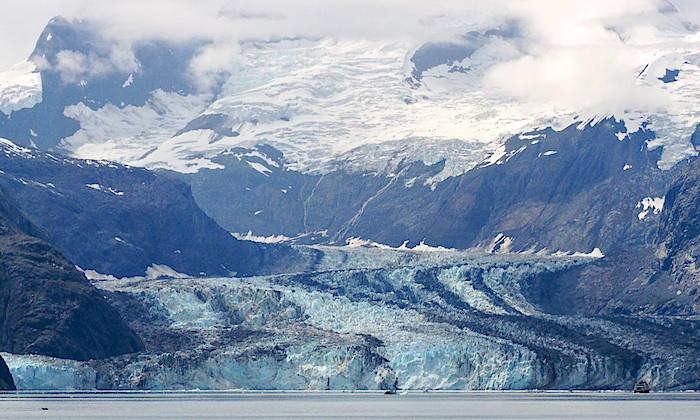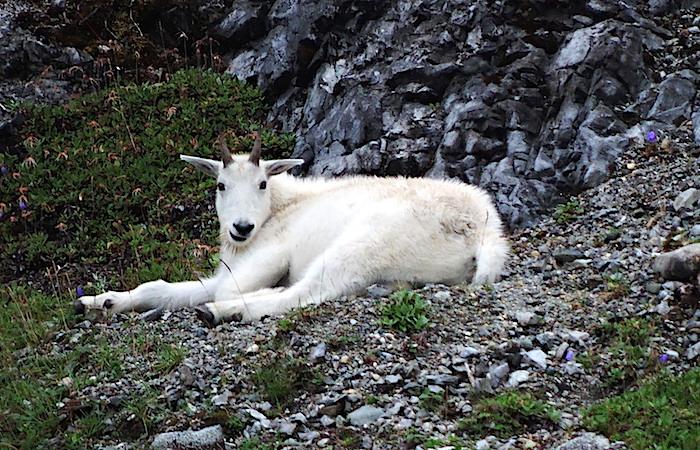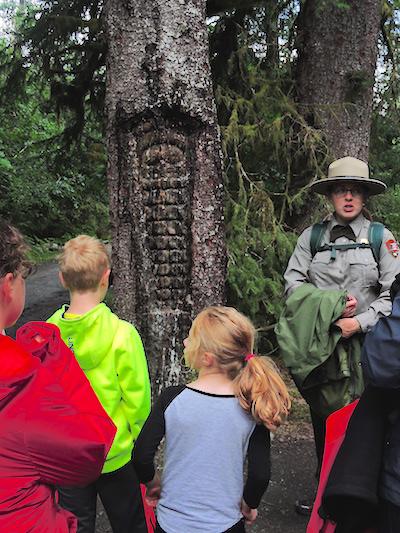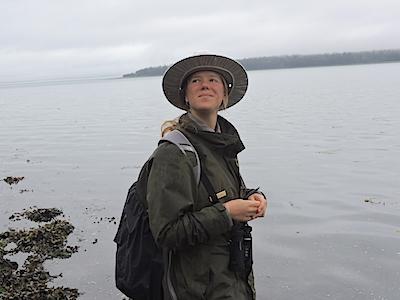
No matter the weather, sunny or rainy, Glacier Bay National Park is a wondrous place to visit/Lee Dalton
There are no faint-hearted interpreters in Glacier Bay National Park.
One or two large cruise ships are allowed to enter Glacier Bay each day. Two or three interpreters board each ship to act as ranger guides while ships traverse the bay to the glaciers. They say it’s an interesting experience. Rangers are ferried out to those vessels aboard a small National Park Service boat and then board big ships using a pilot’s rope ladder or similar arrangement. Huge cruise ships cannot come to a full stop because of nasty tidal currents so transfers are made while under way at about five knots – around seven miles per hour. On days when water is a bit rough, it’s especially adventurous. And then, at the end of the day, there’s another transfer to be made.
I asked one interpreter if anyone had ever gone overboard in the process. “Not that I know of,” she replied. “But y’can sure get a bit wet sometimes.”
I’d dreamed of visiting Glacier Bay for years, and now I was finally there. It was early August and the place surpassed even my wildest imaginings of what it would be like. Now I need to go back and spend a lot more than just three days. There were amazing things to see and learn at every turn.
For example, I had to ask several times to be sure I’d heard right when I was told that the mass of glacial ice that most recently occupied the bay had retreated more than 60 miles in just 250 years. Even more amazing was the story of how the glacier had advanced even more rapidly than that!
That advance during the Little Ice Age, between 1680 and 1750, was so fast it drove Tlingit people from their homes. Tlingit oral histories tell us that glacial ice advanced “as fast as a dog could run.” While that may be a bit of an exaggeration, Glacier Bay is still a place of constantly dynamic change.

If you look, you often can spot some of the park's wildlife, such as this mountain goat/Lee Dalton
Unlike many other places, some glaciers here are growing and advancing while others are shrinking at the same time. Glaciers we see from the lodge’s daily tour boat are tongues of ice extending down carved valleys from massive ice fields that cover Alaska’s and British Columbia’s mountainous seacoast interior. Weight of ice that once covered the bay was so great that earth and water are now rebounding upward just as your mattress does when you get out of bed in the morning. The shoreline below Glacier Bay Lodge is rising by as much as two or three inches every year. Astonishingly fast in geologic terms.
Tides here are amazing. Every six hours water in the bay rises or falls about 20 feet from high to low tide. You can actually see water rising or falling if you stand and watch. In just a few minutes, a rock at water’s edge may be covered or exposed and whirlpools are visible in the channel. Anchored ships swing about their chains first pointing north and then south as water flows in and out of the narrow channel below the lodge.
I could go on and on recounting wondrous things I saw and learned. But what’s it like to be a first-time visitor to this place?
For me, it started when my Alaska Seaplane Cessna 208 on amphibian floats landed at the small Gustavus airport. A bus took me and five others who’d shared my plane ride to Glacier Bay Lodge. Warm, cozy, cabin-like quarters connected by a system of wooden walkways spread out from the main lodge. My window opened onto a wonderworld of rainforest. Up in the main lodge, concessionaire Aramark has a dining room and comfortable lounge area waiting for visitors. Upstairs in the lodge building is the park’s visitor center.
I had expected to pay some really high prices for meals there, but was pleasantly surprised to discover they’re actually reasonable. It was kind of fun, though, when I tried to order bacon with my breakfast eggs. “No bacon,” the server said. Then I asked for white toast. “No white bread,” the server said. “But we do have whole wheat and ham.”
Then he explained. “The supply boat comes on Thursday and we just ran out. Won’t have any until dinner on Thursday.”
Yup, the place really is sort of isolated.

No park visit is complete without an interpretive program/Lee Dalton
Best of all, no television. No cell phones. No distractions and about 19 hours of daylight in early August open up long days for exploring and wondering and discovering.
The first evening I headed upstairs above the dining room to catch an evening ranger program. Ranger Janine welcomed several visitors, including her family who’d flown out from back east. Her talk was excellent – even though it was one of those times when if anything could go wrong, it did. Modern electronics and computers can be wonderful – when they work. But Janine soldiered on. She had built a bit of time lapse into her story, Tapestry of Glaciers, that brought dynamic tectonics of Glacier Bay to life.
Rain was almost constant while I was there. The only blue skies I saw were Mark Kelley’s photos printed in a great book written by Sherry Simpson and available from the park’s cooperating association, Alaska Geographic. The only distant mountains I saw were on interpretive signs. But even gloomy, cloudy, rainy, foggy days had their own special beauty. Everything was green. Green, green and green. And wet. Wooden walkways between cabins were slick and I biffed once. Out in surrounding rain forest and along the beach was nothing but wildness.
A porcupine grazed every evening next to the ranger station at the boat dock. Bears might be encountered anywhere.
Early next morning it was time to head for the dock to board the daily tour boat. Two rangers rode with us for the 67-mile-trip to the far north end of Glacier Bay where Margerie and Grand Pacific glaciers calve their blue ice into the sea. It was cold. It was wet. Wind topside was awfully uncomfortable. It was wonderful.
Rocks with sea lions. A couple of mountain goats lounging on mountainsides. A distant bear on a beach. Sea otters loafing along floating on their backs. And finally, glaciers. Our small tour boat was able to pull in quite close and gave us all a good look. I’d forgotten since my college geology student days how loud glaciers can be when they crack and snap and boom as they move. These were the first tidewater glaciers I’d visited, and every few minutes one of them would calve a massive chunk of ice and create waves that could easily have swamped a smaller boat.
Then it was 67 miles back to the boat dock below the lodge. All 67 miles were just as exciting on the way back as they’d been heading north.
Along the way we had unlimited supplies of hot coffee or hot chocolate hand warmers. Down in the warm window-lined seating lounge they fed us a three-course lunch. A bowl of clam chowder. Then a half hour later, sandwiches and chips and soda. Half an hour after that came big chocolate chip cookies. A meal fit for a king. You just had to be careful not to let water drip from your rainsuit onto your food.
One huge disappointment, however. No whales less than miles away. The only whales I saw up close were two skeletons. One in the visitor center and one in a shelter near the boat dock. Impressive. But they’d have been a lot more impressive with blubber on them while swimming and breaching within range of my camera.
A shortage of interpreters means there are some evenings without programs. But honestly, I don’t think I’d have stayed awake that night through even the best of presentations. I was sound asleep by ten although it was still light outside.

Ranger Brodbeck explained how Native Americans foraged the bay's bounties/Lee Dalton
The next morning, a soggy guided walk along the beach with Ranger Amy Brodbeck. I was the only visitor with her so it was a special treat as she taught me about some of the things Tlingit and Huna people had waiting to be harvested from their seaside larder. She told me how recent agreements will allow native people to return to ancestral shores inside the park and again harvest gull eggs. Later a Tlingit woman I met explained how strict traditions limit the number of eggs that may be taken from a nest. Sacred customs that ensure a continuing supply of eggs forever.
I asked Amy my usual question about the people she works for there. Her response was enthusiastic praise for chief interpreter Tom Vandenberg and Superintendent Phillip Hooge. That was echoed by others with whom I spoke. I know it showed in the quality of my park experience.
When she had to move on to other assignments, I spent the rest of my last day wandering along the shore and then the Forest Trail, through the walk-in campground, past its sturdy bear-proof food locker, and on through one of those holy places that make me realize this is why we have parks.
Finally, lunch and a quick bus ride to the airport where my much-too-short adventure in Glacier Bay came to an end.
No doubt about it. I’m gonna have to go back . . . . and spend a lot more time up there.
For additional reading on Glacier Bay National Park:
Birding In The National Parks: Puffins, Murrelets And More In Glacier Bay National Park and Preserve
By The Numbers: Glacier Bay National Park and Preserve
Discriminating Explorer: Visiting Glacier Bay National Park and Preserve By Mothership
Yogi The Bear Met His Match At Glacier Bay National Park
Birding in the National Parks: Where Are The Kittlitz's Murrelets Going?



Comments
Thanks for bringing back some good memories Lee. And unlike most parks you cannot do a drive through in Glacier Bay nor do you have to worry about crowds. It really is an amazing place. I also highly suggest you go back to see the whales. While I also appreciate your love and support of the parks but forgive me if I point out your conflicting statements. "A shortage of interpreters means there are some evenings without programs" followed by "a soggy guided walk along the beach with Ranger Amy Brodbeck. I was the only visitor". While personalized one on one programs and tours would be wonderful I don't think staffing should be maintained for that.
Thanks, Wild. One thing that struck me about Glacier Bay was that many visitors seemed ready and eager to partake of interpretive programs. (After all, there's no TV) I think my solo trip with Amy Brodbeck was really due to rain. When I left the lodge and headed down toward the ranger station at the boat dock, there were five or six others with me. But it was raining quite hard and they all turned back. Honestly, I almost did, too. But the rain let up just a few minutes later and by the time Ranger Amy and I hit the beach, it was down to a light drizzle that finally stopped altogether.
The photo of the interpreter and visitors at the Tlingit roadsign is much more typical. And that photo was taken about two hours later the same morning.
Great story, Lee, and I agree with your size-up about this wonderful park. My wife and I were able to spend four days there in early June several years ago, and were blessed with sunny weather most of the trip. There was a nice crowd of about 8 or 10 for the guided walk we joined, and we also enjoyed several short hikes on our own. Our experience in the dining room was also very positive - excellent meals, nice variety, great service and superb view. In addition to the all-day boat trip, we took a shorter whale-watching boat trip outside the park to the south of Glacier Bay, and had a superb experience. This isn't an easy park to get to, but sure near the top of my list for a memorable experience.
I absolutley love this site and the informantion it gives!
Lee - I don't know how I missed this article of yours previiously. We stopped in Gustavus for a few days just prior to moving down to the lower 48 from Alaska. Our weather was fairly typical [wet] but we loved it. I was able to go out on a fishing charter one day, and got my halibut and we also enjoyed the daylong trip up to the glaciers. Watching a glacier calve from just offshore is an experience not to be missed.
[edited for typos]